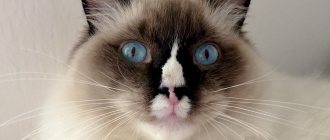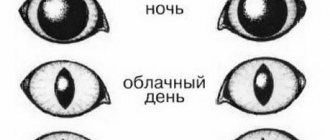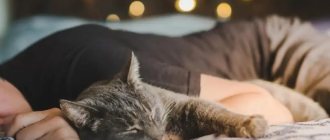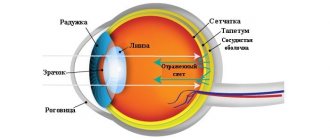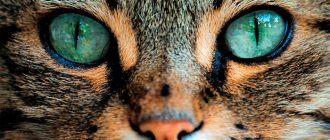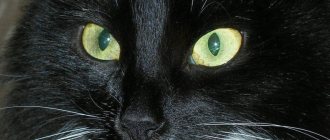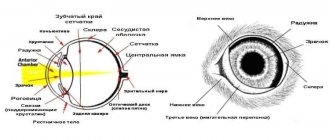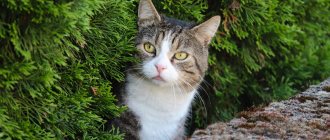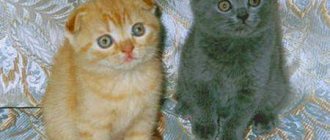Cats can see well in the twilight, but this ability comes with a price.
Have you ever tripped over your striped pet at night and received a puzzled look from him that said, “How could you not notice me?” If yes, then you are aware that you are significantly inferior to your pet in the ability to see in the dark. In fact, its light sensitivity threshold is seven times lower than yours. However, to form images, a cat, like a person, needs light. A cat's vision is unable to distinguish objects in complete darkness. In addition, there is a downside to being able to make do with low light.
Eye structure
Cats have always been considered excellent night hunters. The anatomy and physiology of the visual organs was formed in the course of evolutionary development. It is important for cats to track prey and navigate in the dark. That is why the anatomical structure of the cats’ visual organs is designed in such a way that they are able to distinguish objects in low light conditions.
The structure of a cat's eye consists of three main parts. And each part has its own functional features:
- The outer fibrous part is the outer fibrous membrane, called the sclera, and has a convex shape, reminiscent of a ball. It occupies ¾ of the back surface of the eye, and another ¼ is occupied by the cornea - this is a transparent thin cellular layer that transmits beams of light into the eye organ;
- Vascular part. Located in the middle part of the cat's eye. This is a collection of blood vessels and capillaries through which oxygen and nutrients are transported to all eye tissues. In the place where the sclera and cornea connect, there is the ciliary body. It is controlled by the ciliary muscle, which holds the lens of the eyeball in a certain position. This muscle can tense and relax depending on the cat's attention and the location of the object. Under the influence of such muscle movement, the lens changes its shape. This process is called accommodation. The iris is located on the front of the choroid, and divides the front of the cat's eye into two chambers - anterior and posterior. At the center of the iris is the pupil. It changes its shape depending on the light flux - it narrows in bright daylight, expands in dim light;
- Inner part or retina. Consists of photoreceptors that transform light signals into electrochemical ones. It also transmits the received information to the nervous system. In the retina of the eye there is an optical disk or, as it is also called, a “blind spot” - this is an opening through which blood vessels and the optic nerve exit. Compared to other parts of the retina, the optical disc does not have photoreceptors. In turn, photoreceptors are divided into rods and cones. In four-legged pets, the rods are considered the most developed, since their main function is increased sensitivity to minimal streams of light at night. The function of cones is to recognize the color and clarity of images during the daytime.
Important point
Even knowing why cats see in the dark, some owners conduct incredible experiments on their pets. They place them in a room without windows, such as a pantry, or install a toilet in a dark corner. In such situations, the cones and pupils are not able to help the animal, since even the slightest light source is absent.
An animal in such an environment usually experiences anxiety. This is not due to the fact that the pet sees the other world (as some people believe), but to natural instincts. If the tray is placed in a dark corner, the animal is more likely to find a safer place for itself - on the carpet in the middle of the room, in the shoes of the owners, who are in the illuminated corridor, etc. Whether the pet should be blamed for the offense in this case is a controversial issue.
How cats see in the dark: video
Cat and human vision. What are the differences?
Some people believe that cats see perfectly in complete darkness, but this is not true. Fluffy pets, like people, see nothing in the complete absence of light. But with minimal lighting they are able to recognize objects in the dark much better.
In humans, the ratio of rods to cones is 4 to 1. And in a cat, the number of rods is 25 times greater than the number of cones. This causes cats to prefer a nocturnal lifestyle.
In the daytime, cats are able to clearly distinguish objects at a distance of up to 20 m, and humans up to 40 m. In addition, cats have difficulty seeing objects at close range and identify them mainly based on their olfactory senses.
What else helps a cat navigate in the dark?
In order to “see” in the dark, representatives of the cat family use additional senses in addition to vision - something similar to echolocation, which helps bats navigate at night. The lack of eye muscles that can change the shape of the lens leads to the fact that the pet does not see nearby objects clearly enough. To form a complete picture of space, the cat resorts to the help of its whiskers, which pick up the slightest vibrations. This information is used to build a three-dimensional “map” of the surrounding reality. If, for example, the prey or favorite toy of your household is located within reach (that is, too close to have a clear image), it extends its whiskers, forming a kind of “web” to track movements.
Hearing plays an important role in constructing a picture of reality. Cats perceive low-frequency sounds in the same way as people. However, cat ears are more sensitive to high frequencies - they are able to detect sound vibrations up to 64 GHz (this is an octave higher than the range perceived by dogs). By turning their ears, animals find the source of the sound.
Another way to determine the environment is by smell. A cat's nose has twice as many receptors as a human's; In addition, on the palate of the animal’s mouth there is an additional olfactory organ, the vomeronasal organ, which allows one to recognize chemical odors.
To summarize, we can say that the senses help the cat to hunt in the dark (after sunset and before dawn); Of course, animals do not see in complete darkness, but they are very close to it.
Night and color vision
At night, with minimal lighting, cats are 15 times better than people at distinguishing objects. Of course, for a successful hunt, small predators also use other senses, such as hearing and smell. The human eye perceives all colors, but the cat's eye can only see:
- blue;
- yellow;
- gray and its shades.
Green, red, brown and orange are the same colors for a cat.
The main features of cat vision include:
- Changes in the pupil depending on illumination. This feature helps regulate the beams of light entering the retina.
- Behind the retina of the eye there is a layer of tapetum. It is a “mirror” and reflects light. Thus, a light beam hitting the retina of the eye penetrates the tapetum, is reflected and re-enters the retina. Thus, the eye cells receive a double stream of light, as a result of which the cat’s night vision is enhanced. And the glowing eyes of pets in the dark are also caused by the tapetum layer.
How to stop people waking you up at night
Although cats are not technically nocturnal, they often keep their owners awake. Do you like to wake up in the middle of the night from the stomping of a cat's feet or loud meowing? I think it's unlikely. Your pet's nighttime games will drive anyone crazy, especially if you have to work tomorrow.
And my friends’ cat imagines himself as a night sniper: having climbed up the carpet to the ceiling, he sharply dives down, as if on the head of a sleeping person. And then it soars up to the loud cries of its owner. But as soon as he lies down and turns off the light, the cat goes into a steep dive again. Locking him in another room is not an option; they live in a one-room apartment. But during the day, this wonderful creature is very cute, does not make a sound, curls up in a chair, sleeps until the evening. As the owner says, it is recharging and saving strength for the night.
But there are several effective ways to calm your pet. I hope the information is useful to you.
- Include active games and dinner an hour before bedtime in his evening schedule. As a result, he himself will want to rest. And you will sleep.
- Stir your cat throughout the day, buy interactive toys with which he can jump and play to his heart's content. Why store energy at night?
- Ignore the cat if it wakes you up. Otherwise, he will learn this method for getting food or sharing nightly entertainment. Hide and don't make a sound, otherwise you'll have to play by his rules.
- Don't let your pet into your bedroom. Designate a separate area for him in another room, leaving free access to food, water and toilet.
- But don't be angry with the cat if he wakes you up. He doesn't do this to annoy you. These are just natural instincts.
Found a violation? Report content
Connection with the paranormal world
Many owners say that their pets see a paranormal world that is inaccessible to human perception. This is manifested in the inappropriate behavior of animals: they seem to be observing entities unknown to people. Resting calmly, closing their eyes, they suddenly jump up and begin to rush around, knocking down everything in their path. At this moment, their pupils dilate and their fur stands on end.
Zoologists explain that this behavior is provoked by a stationary picture that appears in front of the animal. The slightest rustle causes this abnormal behavior.
Everyone knows that there is a world that people cannot perceive. For example, pets sense ultrasound or light waves very well, but this is inaccessible to humans. Due to their natural abilities, cats see the world around them much more widely than people.
Fluffy pets, manifesting themselves in this way, only confirm a person’s belief in the existence of ghosts. Although the behavior of cats can be explained:
- Puffing up, the cat arches its back and tail. But can't she just get scared of something sometimes?
- He snorts warily. Perhaps she smelled a new, not very pleasant smell.
- The animal froze and looked carefully into space. Perhaps the cat perceives ultrasounds inaccessible to humans or is simply lost in thought.
- He jumps up and quickly runs away, hissing as he does so. The cat could sense a rodent or a strange cat running past.
It can be assumed that cats see what the human eye cannot see. But whether they really feel the presence of a ghost or it’s just their behavior remains a mystery. In any case, you need to take care of your pet and its perception of the human world.
The vision of cats is a survival tool developed during the process of evolution under any conditions. Thanks to the structure of its eyes, the animal is able to easily recognize potential prey in the dark. Knowing about the peculiarities of cats’ perception of the surrounding world, the owner will be able to better understand his four-legged friend.
What features of vision in cats can be noted?
In addition to range and acuity, a cat's perception differs from a human's in the possible viewing angle. Only one thing is completely identical - binocular vision.
Panoramic vision: viewing angle
The maximum viewing angle for humans is 180°. For cats, it reaches up to 270°, allowing you to catch objects distant behind your back. Despite the blurring of the image outside the field of central vision, it is quite enough to attack a mouse or escape from a sneaking enemy.
Binocularity
Binocular vision is the ability to perceive the world with both eyes at once, followed by translating what is seen into a three-dimensional image. Unlike monocular, it allows you to determine the distance between objects and improves overall acuity.
High frame rate
Another feature of mustachioed predators is their high speed of perception of moving objects. The minimum threshold for them is 50 frames seconds. Animals simply do not react to a slower change.
Quality of vision
Whiskered pets are second only to humans in terms of their sharpness. They only have access to the first line of Sivtsev’s table, hanging in the ophthalmologist’s office. It's all about congenital farsightedness.
Range
Cats have difficulty distinguishing objects located within 0.5-1 m. They find their feeder and toys located right under their nose by smell or with the help of sensitive antennae (vibrissae).
The upper limit is limited to 60 m. More distant objects appear as blurry spots, but the animal responds well to movement. He notices it even at a distance of 500-700 m.
An important factor for hunting
Pets with a mustache are nearsighted. In fact, a clear image of an object is available only at a distance of 20 m. At a distance of 60 m or more, the object becomes so blurry that they cannot distinguish its outline. Visual acuity manifests itself at a distance of an object from 75 cm to 6 m - this is the distance of a cat's jump.
It becomes interesting why this happens, because cats are predatory animals, which means that for them visual acuity is an important factor for a successful hunt . The fact is that their prey is small animals found in the forest and tall grass. There is no need to look at long distances, since the free space is cluttered with foliage and trees.
Man hunted large animals that lived mainly in open spaces. To pursue them, it was necessary to look closely and clearly distinguish traces, blood stains and at the same time look into the distance at a great distance. In the process of evolution, the human eye has gained the ability to perceive clear images both at close and long distances, as well as to distinguish the entire color spectrum.
